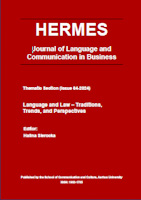Tricky Terms In Legal Translation from and to English: Stepping up to the Classroom Challenge
DOI:
https://doi.org/10.7146/hjlcb.vi64.147310Keywords:
legal language, non-transparent terms, tricky legal terms, false friends, legal translation training, vagueness, enantiosemyAbstract
Legal translation competence includes a high number of sub-competences that legal translation trainees need to master. Therefore, trainers may have no time to tackle issues at the very micro level that are challenging not only for legal translation trainees, but sometimes even for professional translators. Although many such issues are identified in legal translation textbooks, the prevailing holistic approach to teaching legal translation may have led to such issues being sidelined in the legal translation classroom. Drawing on the author’s experience as a legal translation trainer, this paper attempts to fill this vacuum and offer a systematic approach to addressing at least some of these phenomena. A selection of tricky terms will be presented, together with practical activities designed to raise trainees’ awareness of such issues and teach them how to approach them confidently when translating from and to English. Four groups of terms are covered: false friends in general and legal language; vague terms such as good and reasonable; non-transparent terms where complex legal meaning is packed into a simple term (constructive, in lieu of), and enantiosemous terms (apparent, qualified). It is believed that when such phenomena are tackled in isolation, trainees may become better equipped to deal with them successfully the next time they encounter them in an English source text or to use them actively when translating into English.
References
Alcaraz Varó, E., & Hughes, B. (2002). Legal Translation Explained. St. Jerome.
Anesa, P. (2014). Defining Legal Vagueness: A Contradiction in Terms? Pólemos 8(1): 193-209. https://doi.org/10.1515/pol-2014-0011
Bázlik, M., & Böhmerová, A. (2019). Legal English and Its Lexical and Grammatical Structure for Czech Lawyers and Translators: A Proficiency-Level Coursebook Ideal for Both Classroom and Self-Study. Wolters Kluwer.
Black, H. C. (2009). Black's Law Dictionary (9th ed.). West/Thomson Reuters.
Böhmerová, A. (2010). Non-Transparent Legal Terms. In Z. Guldanová (ed.) Teória a prax súdneho prekladu a tlmočenia. Tlmočnícky ústav Filozofickej fakulty Univerzity Komenského v Bratislave. 82-90.
Chromá, M. (2005). Indeterminacy in Criminal Legislation: A Translator’s Perspective. In V. K. Bhatia et al. (eds.) Vagueness in Normative Texts, Peter Lang. 28-48.
Chromá, M. (2014). Právní překlad v teorii a praxi: Nový občanský zákoník. Karolinum.
Crystal, D. (1987). The Cambridge Encyclopaedia of Language. Cambridge University Press.
Cuñado, F. & Gomez, R. ¿Es razonable tanto «reasonable»? Traducción jurídica. https://traduccionjuridica.es/razonable-tanto-reasonable/ (accessed 30 May 2023).
Endicott, T. (2005). The Value of Vagueness. In V. K. Bhatia et al. (eds.) Vagueness in Normative Texts, Peter Lang. 28-48.
Endicott, T. (2011). Vagueness in Law. In G. Ronzitti (ed.) Vagueness: A Guide. Springer. 171-191.
Federal Plain Language Guidelines. https://www.plainlanguage.gov/guidelines/words/use-simple-words-phrases/ (accessed 10 January 2024)
González-Davies, M. (2004). Multiple Voices in the Translation Classroom. John Benjamins.
Jowers, R. (2021) 50 Pairs of Spanish-English Legal False Friends. Léxico Jurídico Español-Inglés. https://rebeccajowers.com/2021/02/16/50-pairs-of-spanish-english-legal-false-friends/ (accessed 18 February 2024)
Kiraly, D. (2010). A Social Constructivist Approach to Translator Education. St. Jerome.
Klabal, O. (2020). Developing Legal Translation Competence: A Step-by-Step Approach. PhD diss., Palacký University Olomouc.
Klabal, O. (2022) Synonyms as a Challenge in Legal Translation Training. Białostockie Studia Prawnicze 27(4), 69–82. https://doi.org/10.15290/bsp.2022.27.04.05
Marmor, A. (2014). The Language of Law. Oxford University Press.
Matthews, P. H. (2007). The Concise Oxford Dictionary of Linguistics (3rd ed.). Oxford University Press.
Matulewska, A. (2016). Walking on thin ice of translation of terminology in legal settings. International Journal of Legal Discourse, 1(1), 65-85.
Mellinkoff, D. (1963). The Language of the Law. Little, Brown.
Newmark, P. (1993). Paragraphs on translation. Multilingual Matters.
Piecychna, B. (2013) Legal Translation Competence in the Light of Translational Hermeneutics. Studies in Logic, Grammar and Rhetoric 34 (47), 141–59. https://doi.org/10.2478/slgr-2013-0027
Prieto Ramos, F. (2011). Developing Legal Translation Competence: An Integrative Process-Oriented Approach. Comparative Legilinguistics: International Journal for Legal Communication 5, 7-21. https://doi.org/10.14746/cl.2011.5.01
Scarpa, F., & Orlando, D. (2017). What It Takes to Do It Right: An Integrative EMT-based Model for Legal Translation Competence. Journal of Specialised Translation 27, 21-42.
Soames, S. (2012). “Vagueness and the law”. In A. Marmor (ed.) The Routledge Companion to Philosophy of Law. Routledge.
Tiersma, P. (1999). Legal Language. University of Chicago Press.
Triebel, V. (2009). Pitfalls of English as a Contract Language. In F. Olsen et al. (eds.) Translation Issues in Language and Law, Palgrave Macmillan. 147–81.
Wiggers, W. J. H. (2011). Drafting Contracts: Techniques, Best Practice Rules and Recommendations Related to Contract Drafting. Wolters Kluwer.

Downloads
Published
How to Cite
Issue
Section
License
Copyright (c) 2024 Ondřej Klabal

This work is licensed under a Creative Commons Attribution 4.0 International License.
Authors who publish with this journal agree to the following terms:
a. Authors retain copyright and grant the journal right of first publication with the work simultaneously licensed under a Creative Commons Attribution License that allows others to share the work with an acknowledgement of the work's authorship and initial publication in this journal.
b. Authors are able to enter into separate, additional contractual arrangements for the non-exclusive distribution of the journal's published version of the work (e.g., post it to an institutional repository or publish it in a book), with an acknowledgement of its initial publication in this journal.
c. Authors are permitted and encouraged to post their work online (e.g., in institutional repositories or on their website) prior to and during the submission process, as it can lead to productive exchanges, as well as earlier and greater citation of published work (See The Effect of Open Access).




